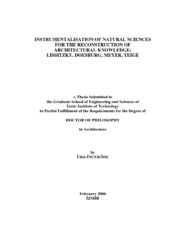Please use this identifier to cite or link to this item:
https://hdl.handle.net/11147/2910Full metadata record
| DC Field | Value | Language |
|---|---|---|
| dc.contributor.advisor | Çıkış, Şeniz | - |
| dc.contributor.author | İnceköse, Ülkü | - |
| dc.date.accessioned | 2014-07-22T13:48:35Z | - |
| dc.date.available | 2014-07-22T13:48:35Z | - |
| dc.date.issued | 2006 | - |
| dc.identifier.uri | http://hdl.handle.net/11147/2910 | - |
| dc.description | Thesis (Doctoral) -- İzmir Institute of Technology, Architecture, İzmir, 2006 | en_US |
| dc.description | Includes bibliographical references (pages: 162-172) | en_US |
| dc.description | Text in English; Abstract: Turkish and English | en_US |
| dc.description | x, 172 pages | en_US |
| dc.description.abstract | The main idea aimed in this dissertation is to analyze the instrumentalisation process of natural scientific knowledge in a struggle for reconstructing architectural knowledge, between 1914 and 1945. This investigation has been made in the scale of the spreading of this effort in Middle and Eastern Europe in general and has been detailed over the most radical form observed in the left-wing architectural discourses.Architecture lost its self-legitimate, unitary structure of knowledge it owned pre-modern period, in the modernization process. In this situation, for reconstructing this unitary structure, architectural theorists oriented towards different fields of knowledge, considering their knowledge more reliable than own. With this struggle, some architectural discourses sustain the old, some presented synthesis proposals, from the end of nineteenth century, some were in the assertion of entirely transforming the architectural knowledge. This struggle gained a new dimension by means of the revolutionary social context formed after the First World War. Especially, in left-wing avant-garde discourses, assigning .a new beginning,. .a new architecture. which can reconstruct a new world was aimed. These discourses have oriented natural scientific knowledge to justify/legitimize their statements and have established a problematic relationship with it.Consequently, this dissertation explains the mechanisms through which architecture implants natural scientific knowledge into its own studies, and presents the transformation that adapted knowledge undergoes. In this way, the problematic relationship between the knowledge of architecture and natural sciences as a result of instrumentalisation is analyzed. This analysis focuses on the discourses of four architectural theorists: Lissitzky, Doesburg, Teige, Meyer. | en_US |
| dc.language.iso | en | en_US |
| dc.publisher | Izmir Institute of Technology | en_US |
| dc.rights | info:eu-repo/semantics/openAccess | en_US |
| dc.subject.lcsh | Lissitzky, El, 1890-1941--Criticism and interpretation | en |
| dc.subject.lcsh | Doesburg, Theo van, 1883-1931--Criticism and interpretation | en |
| dc.subject.lcsh | Meyer, Hannes, 1889-1954--Criticism and interpretation | en |
| dc.subject.lcsh | Teige, Karel, 1900-1951--Criticism and interpretation | en |
| dc.subject.lcsh | Architecture, Modern--20th century | en |
| dc.subject.lcsh | Constructivism (Architecture) | en |
| dc.subject.lcsh | Cubism (Architecture) | en |
| dc.subject.lcsh | Architecture and science | en |
| dc.title | Instrumentalisation of Natural Science for the Reconstruction of Architectural Konowledge: Lissitzky, Doesburg, Meyer, Teige | en_US |
| dc.type | Doctoral Thesis | en_US |
| dc.institutionauthor | İnceköse, Ülkü | - |
| dc.department | Thesis (Doctoral)--İzmir Institute of Technology, Architecture | en_US |
| dc.relation.publicationcategory | Tez | en_US |
| dc.identifier.wosquality | N/A | - |
| dc.identifier.scopusquality | N/A | - |
| item.cerifentitytype | Publications | - |
| item.languageiso639-1 | en | - |
| item.openairetype | Doctoral Thesis | - |
| item.openairecristype | http://purl.org/coar/resource_type/c_18cf | - |
| item.fulltext | With Fulltext | - |
| item.grantfulltext | open | - |
| crisitem.author.dept | 02.02. Department of Architecture | - |
| Appears in Collections: | Phd Degree / Doktora | |
Files in This Item:
| File | Description | Size | Format | |
|---|---|---|---|---|
| T000325.pdf | DoctoralThesis | 27.44 MB | Adobe PDF |  View/Open |
CORE Recommender
Page view(s)
288
checked on Apr 14, 2025
Download(s)
178
checked on Apr 14, 2025
Google ScholarTM
Check
Items in GCRIS Repository are protected by copyright, with all rights reserved, unless otherwise indicated.